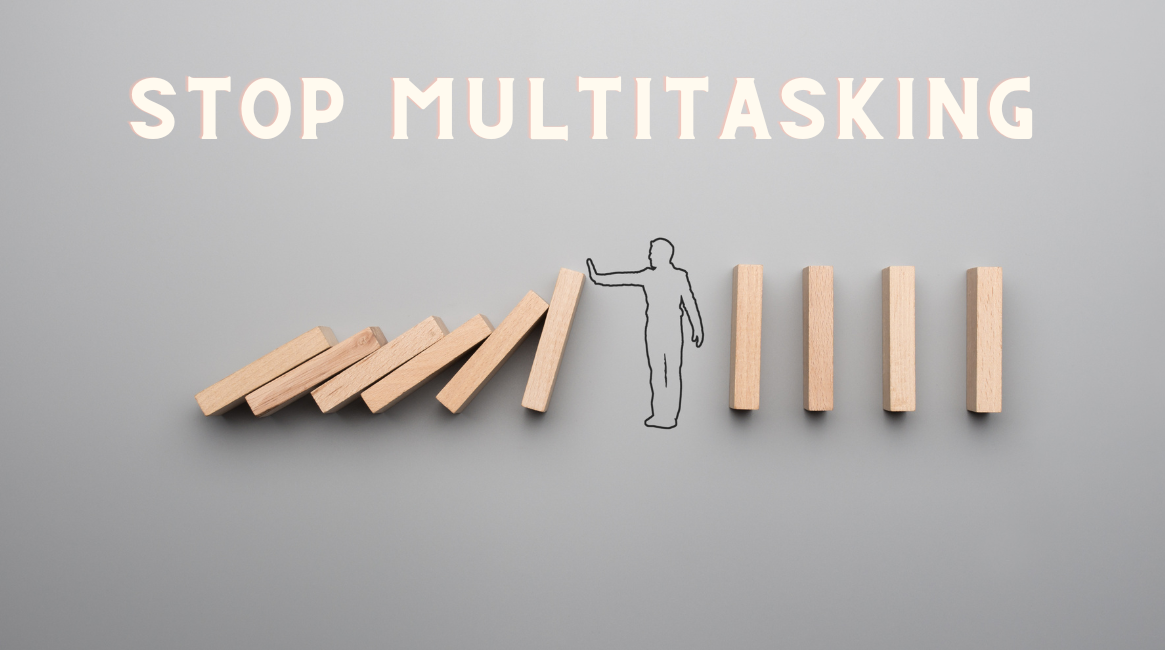Text alert dings from your Apple Watch, an urgent email confirming tomorrow’s meeting, an intern asks about a project, the office phone starts ringing (where’s the secretary?). You glance at the calendar and dart out for a lunch meeting. A nonstop morning with nothing much to show for it.
Sound familiar? Stop multitasking.
Sönke Ahrens, philosophy guru and expert on idea-processing, calls out all alleged multitaskers and summons us to think (and work) better. Because, in reality, multitasking isn’t what you think it is.
“[Multitasking] is focusing attention on more than one thing at a time. Nobody can do that. When we think we multitask, what we really do is shift our attention quickly between two (or more) things. And every shift is a drain on our ability to shift and delays the moment we manage to get focused again. Trying to multitask fatigues us and decreases our ability to deal with more than one task.”
–– How to Take Smart Notes by Sönke Ahrens (pg. 71)
That’s what the kids call a “mic drop.” So why do we brag about our innate multitasking skills? Why do we perceive it as a marketable skill—or worse—even vital to our work and personal lives?
Maybe we’ve lost the art of prioritizing.
In the marathon to finish our top 50 on the agenda today, we miss out on the three most critical.
Maybe we label ourselves as professional “multitaskers” to justify or excuse our short attention spans.
Red flag. Caution. Danger. Your clients, coworkers, employees, and family and you deserve better than a half-focused mind.
If you’re a recovering multitasker, here are a few tips we’ve picked up on from years of balancing and managing hundreds of marketing strategies while giving each client and project undivided attention, regardless of phone calls, last-minute client requests, and the 20 emails that arrived in the last five minutes.
If you’ve been multitasking for years, this framework may feel less productive initially, but track your progress. We expect that you’ll start noticing how individual projects and goals are more thorough, and at the end of the day, you are meeting the most important goals.
Productivity? Check. Peace of mind? Check. Good night’s sleep? Check.
It’s not magic, but here’s our baseline for combating multitasker syndrome and implementing a uni-task (single-focus) approach.
#1. Identify what matters.
Be specific—what really matters today, this week, this month, this year, and five years from now? Why do you do what you do?
What drives you toward what matters? What makes something worthy of your attention? If you can’t answer that question, jump to . . .
#2. Ditch the distractors.
Eliminate the distractors and noisemakers keeping you from what matters—those undoubtedly must be tossed.
For us, some noisemakers are 24/7 email notifications, phone calls during crucial team meetings, interruptions and chats with colleagues, and miscellaneous “must-do” sticky notes that accumulate.
Kendra Adachi, New York Times bestselling author of The Lazy Genius Way, puts it this way:
“Subtracting noise adds meaning to what you already have. Stick with what’s essential” (pg. 148). Too many of our day-to-day time wasters and attention-stealers are simply not essential [refer back to #1].
Distractors may be important in their own right, but that doesn’t qualify them for your uni-tasking attention. Some can easily be ditched by delegation (i.e., hiring a quality answering service to take phone calls during meetings). Others require more strategic organization so they don’t impede your uni-tasking brain bandwidth, which leads us to . . .
#3. Use task-batching and uni-tasking.
Unfamiliar with the term “task-batching”? Here’s the gist: While planning your schedule, batching similar tasks (with identical core functions) in the same block of time can foster clear objectives and save transition time between tasks.
For example, with task-batching, your schedule might look something like as follows:
8 a.m.–8:30 a.m.: Check and respond to emails
8:30 a.m.–11:30 a.m.: Facebook strategy copywriting
11:30 a.m.–12 p.m.: Check emails and make follow-up phone calls
1 p.m.–2 p.m.: Schedule new social media content
2 p.m.–4:30 p.m.: Create graphics for three email newsletters
4:30 p.m.–5 p.m.: Check emails and send brief email updates to clients
It’s not always straightforward or simple, but imagine if instead of following the schedule above, we consistently responded to every new email in real time, made phone calls each moment we thought about it, and paused to answer questions from a colleague every 20 minutes.
Completing that copywriting project before lunch would be unlikely. Instead, it’ll be completed in scattered bits and pieces, absorbing far more brain time and effort because our focus is split and captivated by miscellaneous distractors along the way.
Of course, emergencies come up. But don’t allow haphazard volleyball-style working to be the norm. Work on one task (or a single batch of tasks) and watch how your time-to-productivity ratio improves. And finally . . .
#4. Commit to realistic goal setting.
Unknown goals are unreachable, and multitasking prevails when goals are vague or scattered. When we don’t know what to prioritize, we prioritize everything all at once.
A routine of goal setting pushes us to evaluate what matters, ditch what doesn’t, and use task-batching and uni-tasking to get the job done.
Without clear goals and expectations for yourself and your company and employees, noisemakers and distractors take over. Endlessly busy, but productively deficient.
No more excuses. Stop wasting time.
Whether setting personal or professional goals, Adachi notes, “Small steps are easy. Easy steps are sustainable. Sustainable steps keep moving.” (The Lazy Genius Way, pg. 39). Start with what’s essential and go from there.
It’s a cyclical process—goal setting launches you right back to evaluating what matters. By knowing what matters, you’ll have a foundation for your goals. By setting achievable goals, you’ll remind yourself of what really matters.
So ask yourself, “Where are my routines leading? Where are my goals leading?” Stop multitasking, allow yourself a healthy dose of tunnel vision, and focus your energy on what really matters.


